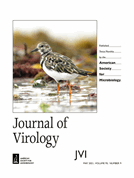Tag: Immunodeficiency Disorders
Granulomatous Amoebic Meningoencephalitis in an Immunocompromised Patient With AIDS and Neurosyphilis
AI SummaryA 49-year-old man presented with fever, headache, vomiting, and altered sensorium. Brain MRI showed a lesion and chest CT showed pneumonitis. He was initially treated for tuberculosis and toxoplasmosis but was later diagnosed with AIDS and syphilis. Biopsy confirmed amoebic meningoencephalitis. The patient died after 19 days. These imaging findings may indicate amoebic meningoencephalitis… Continue reading Granulomatous Amoebic Meningoencephalitis in an Immunocompromised Patient With AIDS and Neurosyphilis
The human cellular protein NoL12 is a specific partner of the HIV-1 nucleocapsid protein NCp7
Jäger S, Cimermancic P, Gulbahce N, Johnson JR, McGovern KE, Clarke SC, Shales M, Mercenne G, Pache L, Li K, Hernandez H, Jang GM, Roth SL, Akiva E, Marlett J, Stephens M, D’Orso I, Fernandes J, Fahey M, Mahon C, O’Donoghue AJ, Todorovic A, Morris JH, Maltby DA, Alber T, Cagney G, Bushman FD, Young… Continue reading The human cellular protein NoL12 is a specific partner of the HIV-1 nucleocapsid protein NCp7
Alterations in gp120 glycans or the gp41 fusion peptide-proximal region modulate the stability of the human immunodeficiency virus (HIV-1) envelope glycoprotein pretriggered conformation
Xu K, Acharya P, Kong R, Cheng C, Chuang G-Y, Liu K, Louder MK, O’Dell S, Rawi R, Sastry M, Shen C-H, Zhang B, Zhou T, Asokan M, Bailer RT, Chambers M, Chen X, Choi CW, Dandey VP, Doria-Rose NA, Druz A, Eng ET, Farney SK, Foulds KE, Geng H, Georgiev IS, Gorman J, Hill… Continue reading Alterations in gp120 glycans or the gp41 fusion peptide-proximal region modulate the stability of the human immunodeficiency virus (HIV-1) envelope glycoprotein pretriggered conformation
Broadly neutralizing antibody epitopes on HIV-1 particles are exposed after virus interaction with host cells
INTRODUCTIONThe envelope (Env) glycoprotein of human immunodeficiency virus type-1 (HIV-1) is the virus attachment protein that interacts with the host-cell receptor CD4 and chemokine receptors CCR5 or CXCR4 to initiate infection (1). HIV-1 displays an average of 7–14 Env trimers per particle. However, this number varies among isolates (2). Env is synthesized as a gp160… Continue reading Broadly neutralizing antibody epitopes on HIV-1 particles are exposed after virus interaction with host cells
Transcription start site heterogeneity and its role in RNA fate determination distinguish HIV-1 from other retroviruses and are mediated by core promoter elements
Carninci P, Sandelin A, Lenhard B, Katayama S, Shimokawa K, Ponjavic J, Semple CAM, Taylor MS, Engström PG, Frith MC, Forrest ARR, Alkema WB, Tan SL, Plessy C, Kodzius R, Ravasi T, Kasukawa T, Fukuda S, Kanamori-Katayama M, Kitazume Y, Kawaji H, Kai C, Nakamura M, Konno H, Nakano K, Mottagui-Tabar S, Arner P, Chesi… Continue reading Transcription start site heterogeneity and its role in RNA fate determination distinguish HIV-1 from other retroviruses and are mediated by core promoter elements
Viral suppression rate at operation triple zero (Otz) and regular art follow-Up programs and associated factors among adolescent clients of Addis Ababa Ethiopia: a comparative cross-sectional study
– Viral suppression is the main goal of currently available treatment and it is used as a primary indicator of successful treatment for human immunodeficiency virus/acquired immune deficiency syndrome (HIV/AID… Continue reading on BioMed Central
HIV-1 reverse transcriptase stability correlates with Gag cleavage efficiency: reverse transcriptase interaction implications for modulating protease activation
Potent targeted activator of cell kill molecules eliminate cells expressing HIV-1 .
CDK8 inhibitors antagonize HIV-1 reactivation and promote provirus latency in T cells
INTRODUCTIONThe ability of HIV-1 to persist within infected cells as an integrated provirus, even during suppressive antiretroviral therapy (ART), represents the main barrier to achieve ART-free HIV remission or cure (1, 2). Various strategies to inactivate or eliminate latent viral reservoirs have been proposed, many of which involve approaches to modulate proviral expression (1, 3).… Continue reading CDK8 inhibitors antagonize HIV-1 reactivation and promote provirus latency in T cells

